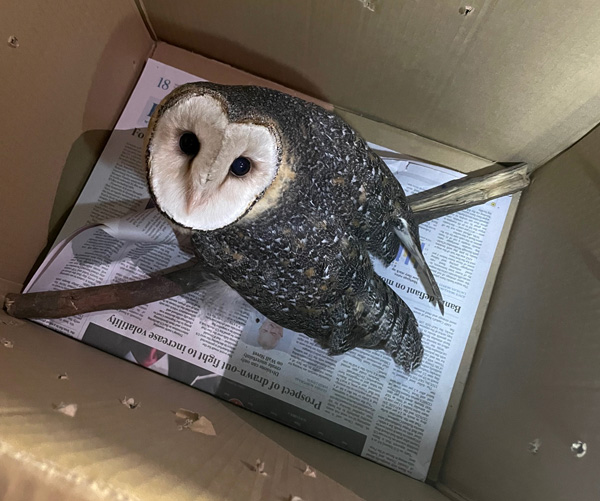By Deborah Jones
Rouge Hoffman and Pete Mace were enjoying the morning sun on their Lovett Bay deck when they saw a group of Noisy Miners and other birds dive-bombing something hidden in a grevillea. A Masked Owl was tucked into the branches and was in trouble. A rescue mission was launched to save what is one of the area’s most striking – and endangered – creatures.
The magnificent Masked Owl – Australia’s second-largest nocturnal bird after the Powerful Owl – should be spread throughout the Northern Beaches but habitat reduction is taking its toll. The Masked Owl roosts and nests in hollows found in mature trees – hollows that can take up to 120 years to form. When there’s an impact on habitat as a result of climate change, bushfires and increasing urbanisation of our coastal areas, so the number of Masked Owls reduces.
Another result of urbanisation? Lots of lawn where once there were trees, and there’s nothing Noisy Miners like better than a big expanse of lawn. A thriving population of clamorous, aggressive Noisy Miners determined to protect their patch is bad news for other native species. They can be driven out, which means less diversity. The balance is destroyed.
“We tried to get the attacking birds away but they kept coming,” says Rouge. Attracted by the hubbub, a bunch of cockatoos also “came to the party”, as Rouge puts it, although they contented themselves with just swooping rather than attacking. Because the Masked Owl didn’t fly away Rouge and Pete were worried it may have been badly injured, or perhaps even poisoned as a result of pesticides entering the food chain.
Specialised knowledge was needed, so a call was made to Jacqui Marlow, who is Sydney Wildlife’s Northern Beaches raptor coordinator. Rouge and Pete also asked Robin Haigh, Lovett Bay’s very own wildlife whisperer, to lend a hand. Jacqui gave instructions on how to capture the owl and Robin was able to get it safely into a box for transport to Church Point, where Jacqui took over.
Jacqui took the Masked Owl, which Rouge and Pete naturally dubbed Zorro, to Taronga Zoo for assessment. There the bird, a juvenile, was flight-tested and its ability to feed itself checked. It was underweight but not injured, and about 10 days later Jacqui was able to bring it back to Lovett Bay. With a group of locals watching, Zorro was released. “The fact that we have something in this area that is so rare and so precious is just amazing,” says Jacqui.
Since the rescue there have been some sightings of Masked Owls in the area and a recording system has been set up to keep an eye out for them. This story has a happy ending, but Rouge makes the point that to keep these precious creatures safe, it’s important not only to protect habitat but also to be very careful with pesticides. Masked Owls feed on small mammals including rodents, so a pesticide used to eliminate rats or mice can find its way into the system – and into the owl. (See the report by BirdLife Australia on bromadiolone below.)
From Pittwater Online News:
Whole Lot Closer To Keeping Bromadiolone Out Of Bird Food Chains
June 23, 2021: BirdLife Australia
This afternoon, the Australian Pesticides and Veterinary Medicines Authority (APVMA) announced that they are intending to refuse the NSW Government’s emergency permit application to use bromadiolone to end the mouse plague, on the grounds of environmental concerns.
This is a huge win in the fight to stop the NSW Government from rolling out of thousands of litres of this highly toxic second generation rodenticide across farms – the equivalent of “napalming” rodents.
APVMA Chief Executive Officer, Ms Lisa Croft, said that “the APVMA’s primary concern is environmental safety, particularly in relation to animals that eat mice” – which is what we have been warning all along.
If bromadiolone is allowed to enter our natural food chains, the consequences for our native birds could be catastrophic. While there’s no evidence that bromadiolone will stop the mouse plague, we do know that it will kill birds of prey – while affecting everything from fish to reptiles, marsupials to livestock and even pets.
BirdLife Australia’s Urban Birds Program Director Holly Parsons said the APVMA had made the right decision.
“We still have concerns about the impacts that second generation anti-coagulant rodenticides have on our wildlife but are glad that such a mass quantity has been stopped from entering the ecosystem,” she says.
“We note the APVMA have approved 6 additional permits to distribute zinc phosphide, and call again on the APVMA to implement additional monitoring of potential impacts to wildlife from this chemical. While it does not spread throughout natural food chains in the same way as bromadiolone would, zinc phosphide is still highly toxic, and should be distributed with caution.”
NSW DPI has 28 days to respond to the proposed decision before the APVMA makes its final decision, which we will be monitoring closely.
A huge thank you to the thousands of people who signed our petition calling on the APVMA to refuse this application. Please sign if you haven’t already to continue to apply the pressure: https://www.actforbirds.org/ratpoison#protectourbirds
